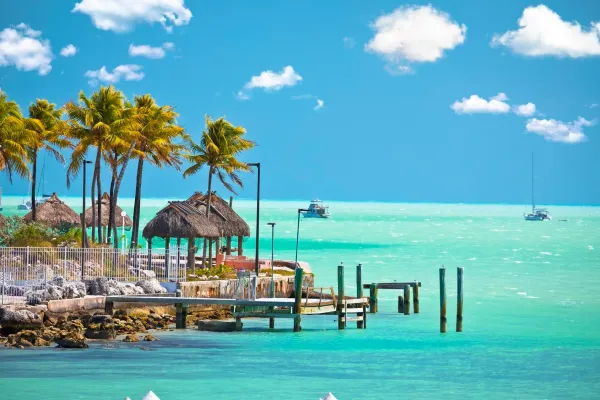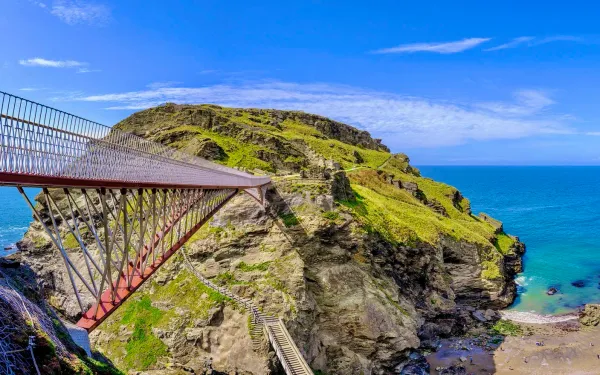Miami's Art Deco District: A Journey Through Time
Discover the charm of Miami's Art Deco District, a historical journey through iconic architecture, vibrant culture, and timeless style.

In this page:
- The History and Significance of Art Deco in Miami
- Iconic Buildings and Architectural Features
- Art Deco District Today: A Modern Fusion of History and Culture
- Guided Tours and Educational Resources
- The Art Deco District in Popular Culture
- Dining and Shopping in the Art Deco District
- Preservation and Future Developments
Welcome to the Art Deco District in Miami, an architectural marvel and a cultural icon nestled in the heart of Miami Beach, Florida. Located along the world-famous Ocean Drive, this district is an iconic representation of a bygone era. Its colorful buildings, geometric shapes, and unique design elements have become a captivating sight for both visitors and locals.
As we embark on this historical journey, we explore one of Miami's most celebrated neighborhoods, where architecture serves as a testament to the city's dynamic past and vibrant present. It is also one of the most well-preserved examples of Art Deco architecture in the world.
This exploration of the Art Deco District is not just about admiring beautiful buildings; it’s about uncovering the rich tapestry of history, culture, and art that has shaped this area into a world-renowned destination. Get ready to step back in time and discover the allure and charm of a district that has become synonymous with Miami's identity.
1. The History and Significance of Art Deco in Miami

The Art Deco movement in Miami is a tale of resilience, creativity, and architectural innovation. Understanding its roots and significance is key to appreciating the district's charm and historical importance.
Exploring the Roots of the Art Deco Movement and Its Arrival in Miami
The Art Deco style, characterized by its emphasis on geometric shapes, vibrant colors, and ornate detailing, originated in Europe in the early 20th century.
This movement reached Miami in the 1920s and 1930s, a time when the city was experiencing rapid growth and development. The style resonated with the city’s coastal setting, lending itself to the creation of a unique architectural landscape that combined luxury, glamour, and tropical motifs.
Impact of the 1926 Hurricane and the Subsequent Architectural Transformation
The devastating 1926 hurricane dramatically altered Miami’s architectural landscape. In its aftermath, a wave of reconstruction began, marking the transition to the Art Deco style.
This era saw the construction of buildings that not only adhered to the aesthetic principles of Art Deco but were also designed to be more resilient against future storms. The use of sturdier materials and streamlined designs became prevalent, shaping the architectural character of Miami Beach.
The Role of Preservation Efforts in Maintaining the District's Legacy
By the mid-20th century, many of the Art Deco buildings had fallen into disrepair and were at risk of demolition. The formation of the Miami Design Preservation League in the 1970s played a pivotal role in protecting and preserving these architectural treasures.
Thanks to these preservation efforts, the Art Deco District was listed on the National Register of Historic Places, ensuring the protection of its unique architectural heritage.
The district's preservation has been a driving force in Miami's cultural and tourism revival, turning the area into an iconic destination that draws millions of visitors each year.
2. Iconic Buildings and Architectural Features

The Art Deco District in Miami is a living museum of 20th-century architecture, boasting an array of landmark buildings and distinctive design elements that define the style. This part of the city is not just a place but an experience, where every building tells a story through its unique architectural features.
Highlighting Landmark Buildings
The Delano Hotel is a quintessential example of Miami Art Deco, with its sleek façade, elegant lines, and classic design. This iconic hotel has been a symbol of luxury and style since the 1940s.
The Colony Theater is another notable landmark, a stunningly restored 1930s cinema that showcases the glamorous side of Art Deco, complete with its original neon marquee.
The Wolfsonian-FIU, a museum and research center, not only contains an extensive collection of Art Deco artifacts but is also housed in a historic building that exemplifies the style.
Exploring Unique Architectural Elements
Miami's Art Deco buildings are known for their ziggurat rooflines, a tiered design that adds a sense of grandeur and verticality to the structures.
Neon lighting is another hallmark of the district, used to accentuate the geometric shapes and lines of the buildings, especially vibrant at night.
Nautical motifs are prevalent in many Art Deco designs in Miami, reflecting the city's coastal location. These include features like porthole windows, ship-like railings, and marine-inspired adornments.
The Influence of Tropical Colors and Geometric Designs
The use of tropical colors – pastels, bright hues, and contrasting shades – is a defining characteristic of Miami’s Art Deco architecture. These colors highlight the playful and flamboyant aspects of the style.
Geometric designs are a staple of Art Deco, with buildings often featuring symmetrical shapes, sunbursts, and streamlined forms that create a sense of modernity and elegance.
3. Art Deco District Today: A Modern Fusion of History and Culture

Today, the Art Deco District stands not only as a testament to Miami's architectural history but also as a vibrant, living neighborhood that seamlessly blends the past with the present. Its streets buzz with a contemporary vibe, while proudly displaying the district's rich cultural and architectural heritage.
District’s Contemporary Vibe
The Art Deco District today is a dynamic area, pulsating with life and energy. Its historic buildings house trendy cafes, boutique hotels, and chic bars, making it a hotspot for both locals and tourists.
The district has evolved to become a central part of Miami's cultural and social scenes. It's a place where history is celebrated, and modern lifestyle trends are embraced, creating a unique atmosphere that's both nostalgic and forward-looking.
Integration of Modern Businesses and Entertainment Within Historic Structures
Many of the district's historic buildings have been revitalized and repurposed, accommodating a variety of modern businesses. These structures now host everything from luxury fashion boutiques and contemporary art galleries to sophisticated nightlife venues.
This blend of the old and the new has given the Art Deco District a unique character, where the glamour of the 1930s coexists with the cutting-edge trends of today.
Annual Events That Celebrate the Art Deco District's Heritage
The Art Deco Weekend, an annual event organized by the Miami Design Preservation League, is a celebration of the district’s architectural, cultural, and historical legacy. The festival features classic car shows, guided tours, lectures, and live music, drawing crowds from around the world.
Other events, such as film festivals and cultural parades, frequently take place in the district, highlighting its status as a thriving hub of arts and culture in Miami.
4. Guided Tours and Educational Resources

For those eager to delve deeper into the Art Deco District's rich history and architectural significance, a variety of guided tours and educational resources are available. These tours and resources offer insightful perspectives and in-depth knowledge, enhancing the experience of exploring this iconic neighborhood.
Information on Guided Walking Tours, Self-Guided Tours, and Virtual Experiences
Guided Walking Tours: Numerous companies and organizations offer guided walking tours of the Art Deco District. Led by knowledgeable guides, these tours delve into the architectural styles, history, and cultural anecdotes of the neighborhood. The Miami Design Preservation League (MDPL), for instance, offers regular guided tours that are both informative and engaging.
Self-Guided Tours: For those who prefer exploring at their own pace, self-guided tour options are available. The MDPL provides maps and brochures that can be used to navigate the district and learn about its key buildings and features.
Virtual Experiences: Virtual tours have also become popular, offering a digital way to explore the Art Deco District. These online resources provide a comprehensive overview of the area, accessible from anywhere in the world.
Educational Resources and Museums
The Art Deco Museum, located in the heart of the district, is an invaluable resource for understanding the architectural and cultural significance of Art Deco in Miami. The museum showcases artifacts, photographs, and exhibits that tell the story of the district’s development.
The MDPL Art Deco Welcome Center serves as a starting point for many visitors. It offers educational materials, exhibits, and information on preservation efforts, making it an essential stop for those looking to enrich their knowledge of the area.
In addition to these, local bookstores and libraries in the area often carry literature and historical documents about Miami's Art Deco architecture, providing further learning opportunities for enthusiasts and scholars.
5. The Art Deco District in Popular Culture

The Art Deco District of Miami is not just an architectural gem; it has also played a significant role in popular culture. Its distinctive aesthetic has made it a favored backdrop in various forms of media, influencing fashion, design, and the arts.
Art Deco District’s Appearances in Films, Television, and Photography
The Art Deco District's unique style and vibrant atmosphere have made it a popular location for films and television shows. Its picturesque streets and colorful buildings have been featured in classic TV shows like "Miami Vice", which showcased the district's style and contributed to its fame.
In film, the district’s backdrop has been used to evoke a sense of glamour and nostalgia, appearing in movies such as "The Birdcage" and "Scarface."
Photographers, both professional and amateur, are drawn to the district’s aesthetic, capturing its pastel-hued facades and retro charm, making it a widely recognized and celebrated locale in photography circles.
Its Influence on Fashion, Design, and Popular Culture
The influence of the Art Deco District extends beyond architecture; it has significantly impacted fashion and design. The area's style has inspired collections from fashion designers who are drawn to its blend of vintage glamour and modern simplicity.
The district’s motifs, color palettes, and geometric patterns have been incorporated into various design elements, from graphic design to interior decor, influencing trends and aesthetics beyond Miami.
6. Dining and Shopping in the Art Deco District

The Art Deco District in Miami is not only a feast for the eyes but also a delight for food enthusiasts and shoppers. The area boasts a variety of period-themed restaurants and cafes, as well as shopping experiences that reflect the iconic Art Deco style.
Recommendations for Period-Themed Restaurants and Cafes
Dining in the Art Deco District can be a throwback experience, with several eateries and cafes embracing the 1930s and 1940s ambiance. The Front Porch Cafe and News Cafe offer a blend of modern cuisine with a touch of the Art Deco era in their decor and atmosphere.
Gianni's at The Villa Casa Casuarina, formerly the Versace Mansion, offers a luxurious dining experience that transports guests back to the opulent Art Deco period, serving contemporary Mediterranean cuisine in a historic setting.
For a casual yet authentic Art Deco experience, cafes like A La Folie Cafe and Espresso Bar at The Webster provide a cozy ambiance, perfect for enjoying a coffee or light meal amidst the architectural beauty of the district.
Shopping Experiences That Reflect the Art Deco District Style
Shopping in the Art Deco District is a unique experience, with numerous boutiques and shops featuring items that capture the essence of the Art Deco era. From vintage clothing stores to shops selling Art Deco-inspired souvenirs and home decor, there’s something for every aficionado of the style.
The Webster Miami, housed in a historic Art Deco building, is a luxury multi-brand boutique offering high-fashion clothing and accessories in an architecturally significant space.
For those looking for Art Deco memorabilia, shops like Art Deco Gift Shop by MDPL offer a range of items from books and posters to jewelry and home accessories, all celebrating the Art Deco aesthetic.
7. Preservation and Future Developments

The Art Deco District in Miami is a shining example of successful historic preservation, yet it continues to evolve and adapt. Understanding the balance between preserving its rich history and embracing future developments is crucial to maintaining the district's charm and significance.
The Ongoing Efforts to Preserve the Art Deco District
Preservation efforts in the Art Deco District Miami are largely spearheaded by organizations like the Miami Design Preservation League (MDPL), dedicated to protecting the architectural integrity of the area.
These efforts include advocating for legal protections, educating the public about the district's historical importance, and working with developers and the city to ensure that renovations and restorations respect the original Art Deco designs.
Restoration projects often involve meticulous research and careful craftsmanship to maintain the distinctive features and colors that define the Art Deco style.
Future Developments and How They Balance Modernity with Historical Preservation
As Miami continues to grow and develop, the Art Deco District faces the challenge of integrating modern amenities and new constructions while preserving its historical character.
Future developments in the district are subject to strict guidelines to ensure they complement the existing Art Deco architecture. This includes regulations on building heights, façade designs, and color schemes.
The district has seen successful examples of blending old with new, where modern hotels, residential buildings, and commercial spaces coexist harmoniously with historic structures, demonstrating that development and preservation can go hand in hand.
In summary, a visit to Miami's Art Deco District is more than just a stroll through a neighborhood; it's a journey through time, an immersion in a unique architectural world, and a celebration of a vibrant cultural heritage. The district stands as a testament to the creativity and vision of the past, as well as the commitment to preservation and adaptive reuse in the present.
Walking through the Art Deco District, with its pastel-hued buildings, geometric designs, and striking neon lights, visitors experience a unique blend of history, art, and culture. Each building tells a story, each street corner holds a piece of history, and the entire district echoes the glamour and elegance of a bygone era. The area’s fusion of historic architecture with modern life creates an atmosphere that is both nostalgic and vibrantly contemporary.
Visitors to the Art Deco District are encouraged to delve deeper into this architectural marvel. Whether exploring on a guided tour, enjoying a meal in a period-themed restaurant, shopping in Art Deco-style boutiques, or simply wandering the neon-lit streets, there is an abundance of ways to engage with and appreciate this timeless jewel of Miami.
As you explore, let the Art Deco District reveal its many layers, each rich with history and beauty, and find yourself transported to an era characterized by style, innovation, and artistic exploration. This district is not just a must-visit for architecture enthusiasts but for anyone looking to experience a unique and integral piece of Miami's cultural and historical tapestry.





